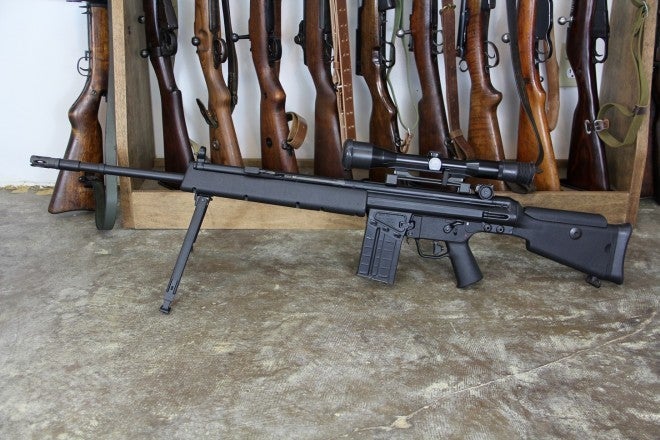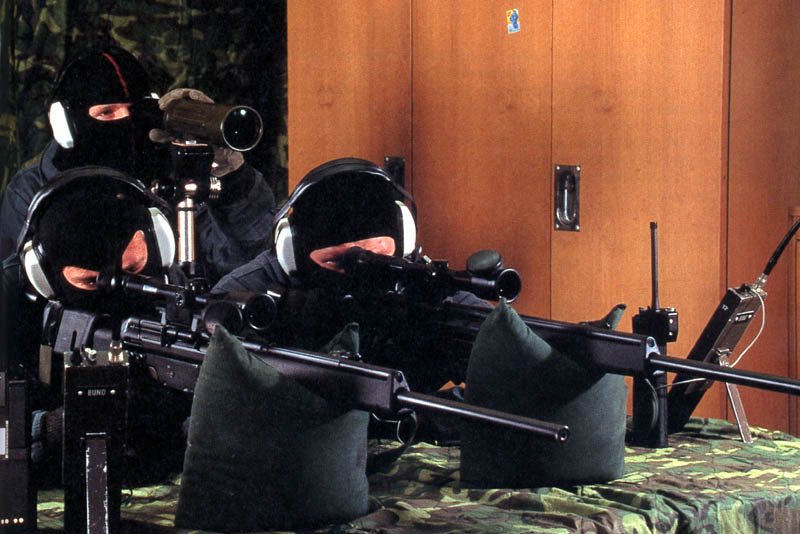There was a period of time in the 20th century when H&K was producing 2,000 G3 battle rifles a day. These rifles served not only the West German armed forces, but many of the West’s armed forces and remained the top competitor with the FN FAL as far as proliferation is concerned. The MSG90 is the highest evolution of the G3 battle rifle, and is itself a PSG1 rifle with a few more features to make the rifle more than a stationary precision rifle.
As stated, the MSG90 is based on the famous PSG1 which was developed after the German government’s failure at the 1972 Munich Olympics at which 17 people (including 11 Israeli coaches and athletes) were killed due to a very bungled response. The Germans recruited marksman who were not professionally trained, but rather police officers and such who shot recreationally on weekends, and equipped them with G3 rifles with iron sights. The men selected even declared that they were not sharpshooters, but regardless they were placed several hundred yards away and a lot was expected of these individuals. The Munich Massacre unfortunately resulted in the loss of many innocent lives, but as a result, the Germans realized they needed to be better prepared for something like this in the future. Many things were created in response to Munich, including the P7 pistol, the elite GSG-9 counter-terrorist unit, and a new rifle to aide in precision shooting; The PSG1.
The PSG1 gave marksmen a tool that they desperately needed in order to neutralize a threat with success at a distance. The Germans realized they needed a semi-automatic rifle with a large capacity too for quick follow up shots, so a bolt gun was out of the question. In response, H&K took what they had (the G3 platform) and radically altered it to shoot more accurately. The PSG1 has:
- Receiver reinforcement rails to increase strength and reduce flexing
- A special trunnion that wraps around more of the barrel to reduce whip
- Special bolt group that includes serrations for the bolt closing device and a special locking piece
- A polygonal cold hammer forged barrel that is free floated
- An extended cocking tube with the handle placed far forward
- Half moon shaped “rollers” for consistent lockup and bolt gap
- 6x Schmidt and Bender optic
With these modifications the PSG1 was a true sub-MOA rifle that was quite remarkable for a semi-auto in the early to mid 1970s. Considering that roller lockup is very crude compared to a system with a rotating bolt, it is impressive that precision rifles based on the famous HK roller delayed blowback system can perform the way they do.
So where does the MSG90 play into this? Well, all the above points are true of it as well, but the MSG90 is a lighter and more mobile version of the PSG1. The rifle that is the subject of this review is the MSG90A1, a rifle that was commissioned by the United States Government to arm the Marine Corp Security Force and FAST teams. The A1 features a 10x Schmidt and Bender optic, iron sights borrowed from the HK21 machine gun, an improved stock, and a barrel that is threaded and has a harmonic stabilizer to reduce barrel whip. The rifle is still in production too, but the MSG90 has never been made available to civilians due to one simple fact: it features a swing down lower and the ATF considers any of the G3 derived firearms with a swing-down to be a machine gun. However, twenty year HK emplyee Jim Schatz has said that there are four MSG90s out there in civilian hands and that the ATF originally deemed these not machine guns, so who knows where these are today? The good news is that several kits made their way onto the market that allow for rifles like this one to be built.
Anyways on with the show. Here we can see the side profile of the MSG90 with its silent bolt closing device, which works wonders relative to the noise produced by the “HK slap”.
Notice also how the scope is mounted to two picatinny rails welded on top of the receiver rather than the old claw mounting system.
Here you can see the trunnion:
Very odd looking compared to a G3’s (which ends inside the receiver).
Next up is how the barrel is free floated. The cocking tube is extended and the traditional H&K 3 ring front sight tower is not present. It looks like they just cut one in half and welded it on!
And lastly, here is a close up of the bolt head with the exposed rollers. The rollers are made of titanium and are crescent shaped rather than true cylinders:
For comparison, here is a regular G3 bolt and carrier:
So the MSG90 has some really cool features that would make a G3/91/PTR/JLD etc. owner do a double take, but how do these contribute to accuracy? Well for that I would have to arrange to get this gun out to the range.
Let me preface this by saying that I have very little experience with precision rifles. I have no formal training, have never shot in bench rest or an extreme accuracy oriented competition, and have never really been behind a big fancy DMR/precision rifle so I was really excited about this one. I bought some SSA 168 grain ammunition and went to town. I figured me behind the trigger would be a good measure of accuracy since I am not a complete newbie, but new to this kind of rifle (I have always been an “accuracy by volume” kind of guy).
First of all I feel bad for the designated marksman who would have to lug this around; The MSG90A1 weighs 15.4 pounds (7 kilos), just a pound and a half shy of the M249 SAW. I got a quick crash course in how to shoot this thing properly, and proceeded to get behind the rifle, using the factory equipped bipod and my shooting bag as a rest for the stock.
The trigger breaks at 3.3 pounds and is very comfy with the nice wide trigger boot. I had set a target at 100 yards to perform five 5 shot groups on after I got comfy with the gun (I dialed it in and put a hurting on some steel first).
Here I am ready to try and shoot:
And here the rifle is in full recoil flinging brass into the next county:
I must say that the big rubber recoil pad helps significantly with felt recoil, and the rubber grommet on the scope prevents any possibility of leaving the range with a nice big scope kiss on your noggin. Shooting this gun was a real pleasure, and I had a lot of fun doing it, but how did it perform?
Well the calipers don’t lie! Here is my best of five:
At 0.444 inches that translates to 0.424 MOA, making this a legitmately sub-half MOA rifle, especially in hands more capable than mine. The best part however is that I was able to consistently shoot sub MOA, with an average group of 0.625 inches! I feel that I could have done better with more magnification too, but the fixed 10x optic is very clear and adheres to the DMR principle.
So onto the bullet points:
The Good:
- Accurate
- Reliable
- Great trigger
- Fun to shoot
- Familiar G3 controls
The Bad:
- Fixed 10x magnification
- Heavy rifle to field
- Mangles brass (like all G3 type rifles)
The Ugly
- The ATF considers these semi-auto rifles a machine gun
- Not importable into the USA for civilians to own due to the 1989 ban
- A set of the special titanium rollers are $300!
So the MSG90A1 is a fantastic rifle that provides an incredible shooting experience, and it is a real bummer that this thing has been deemed a machine gun by the United States.
 Your Privacy Choices
Your Privacy Choices











